Introduction to the New River/Mexicali Sanitation Program
NEW! The New River Improvement Project Fact Sheet
New River: The present day channel of the New River was created in 1905-07 when the Colorado River washed out diversionary works, and the entire Colorado River flow coursed into the Salton Basin creating the New and Alamo River channels and the present Salton Sea, thus the name "new" river. These surface waters are within the Salton Sea watershed, which is a transboundary watershed that includes the Coachella and Imperial Valleys in the United States and a portion of the Mexicali Valley in Mexico.
Currently, the New River's headwaters originate about 15 miles south of the City of Mexicali, in the Mexicali Valley, Mexico. The New River carries urban runoff, treated municipal wastes, untreated and partially treated industrial wastes, and agricultural runoff from the Mexicali Valley into the United States. After it crosses the International Boundary at Calexico, California, theNew River travels about 60 miles through Imperial County before it discharges its entire flow into the Salton Sea. By the time the New River reaches the Salton Sea, about 2/3 of its flow consists of wastewater in the form of agricultural runoff from Imperial County. Flows in the New River at the International Boundary with Mexico have been reduced by as much as 40% during the last 10 years due to a number of factors, including reduction of agricultural runoff and municipal wastewater discharged into the New River and its tributaries in Mexico. Currently, the New River flow is approximately 81,590 ac-ft/yr at the International Boundary (USGS, 2013). At its delta with the Salton Sea, its flow is approximately 394,000 acre-feet/year, which makes it one of the two main tributaries to the Salton Sea--the other main tributary being the Alamo River.
New River at International Boundary: Historically, the New River has been recognized as a significant pollution problem since at least the late 1940s, primarily because of its extremely high concentrations of fecal coliform bacteria and offensive odor at the International Boundary. The early history of New River pollution is vague, but it is believed to be closely aligned with population growth. In 1920, the total population of Mexicali was only 6,200 people. In 1955, it was estimated that raw sewage from approximately 25,000 people was being discharged into the New River from Mexicali. In 1975, the population jumped to over 100,000 people. The present population of Mexicali is believed to be approximately 1 million (INEGI, 2010). A focal point of early complaints regarding New River pollution was odor. In the early fifties, the odor of the river near the boundary, particularly at night, was oftentimes overpowering. Beginning around 1956, the flows of the New River at the boundary increased considerably due to development of agricultural drainage return flows from Mexicali Valley. This dilution water temporarily alleviated the odor problem, but in the sixties the problem became increasingly noticeable as sewage loading increased with the population. Similarly, due to the recent industrial growth in Mexicali, industry is now also a significant source of New River pollution. In the mid 1980's, Mexico and the United States began to work cooperatively to address New River pollution from Mexico. However, it was not until 1992 when both countries recognized that the magnitude of the problem was significantly more severe than what they envisioned. By then, anywhere from 10 up to 20 million gallons per day of raw sewage were routinely present in the New River as it entered California.
The Regional Board has primary responsibility for addressing the New River's water quality problems attributable to activities in the United States. It has been controlling pollution from nonpoint sources of pollution—mainly agricultural runoff from the Imperial Valley - by implementing the State's Nonpoint Source Management Plan and the State's Watershed Management Initiative, which calls for development and implementation of Total Maximum Daily Loads for those constituents impairing the river. It also controls pollution from Imperial Valley point sources discharging into the New River (e.g., domestic wastewater treatment plants) through the National Pollutant Elimination Discharge System (NPDES) regulatory program. The United States Environmental Protection Agency (USEPA) and the US Section of the International Boundary and Water Commission (US IBWC) are the two US agencies with responsibility for Border pollution.
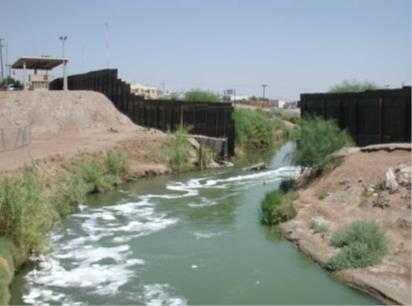
Short And Long-Term Strategies to Improve The Water Quality
Regional Water Board staff sampling New River in Calexico: The California Regional Water Quality Control Board, Colorado River Basin Region, has been actively involved in the cleanup of the New River and has been a significant force in molding the proceedings. The Regional Board has monitored the water quality of the New River since 1975. In 1995, the United States Environmental Protection Agency (USEPA) provided funds to the Regional Board to monitor and document the water quality at the International Boundary on a monthly basis. The main purpose was to assess to what degree the sanitation projects improve water quality of the New River at the boundary. Since 2002, and as resources have allowed, the state has been funding the monitoring. Monitoring data indicate the New River is polluted by bacteria, silt, nutrients (e.g., nitrate and phosphate), pesticides, and trash. See water quality data for the New River at the International Boundary.
In 1980, the Unites States and Mexico Sections of the IBWC adopted Treaty Minute 264, which established water quality standards for the New River at the International Boundary and called for the elimination of Mexico's raw sewage discharges into the New River by 1982. In spite of this, discharges of 10 to 20 million gallons per day (mgd) of raw sewage continued because both governments had underestimated the magnitude of the problem. In 1992, US and Mexico adopted Treaty Minute No. 288, which established a long-term sanitation strategy for the New River at the Border and divided the sanitation project into Immediate Repairs (a.k.a. quick fixes"), the Mexicali I, and the Mexicali II projects. The projects total about $50 million dollars and were funded by both countries through the North American Development Bank (NAD Bank)-a binational organization created by the North American Free Trade Agreement (NAFTA). The Border Environment Cooperation Commission (BECC)-the NAD Bank's sister institution-is responsible for certifying the projects meet a series of environmental criteria and qualify for funding. The Mexicali I and II sanitation projects originally received certification by the BECC on December 5, 1997, and January 7, 1998, respectively.
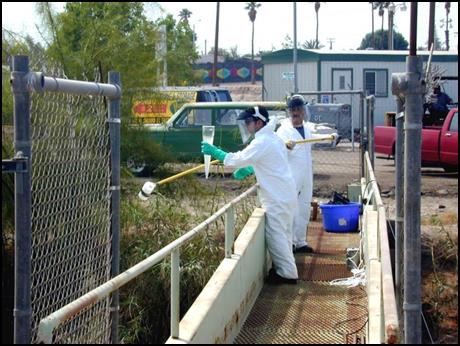
Quick Fixes
New Pumps (shown in grey) at Pumping Plant No. 1: The Quick Fixes were funded through a cost sharing agreement between both countries. The U.S. 55% and Mexico contributed 45% of the $7.5-million total cost for the Quick Fixes. These emergency projects were implemented under the supervision of a Binational Technical Committee1 (BTC). The BTC has representatives from CILA (IBWC, Mexican Section), CESPM (State Public Services Commission of Mexicali), CNA (National Water Commission), SAHOPE (Secretary of Human Settlements and Public Works) and the Municipality of Mexicali for Mexico; and the US IBWC Section, USEPA, California State Water Resources Control Board, Regional Water Quality Control Board, County of Imperial, and the Imperial Irrigation District for the United States. The BTC has led to improved communication and technology transfer between the two countries. IBWC declared the Quick Fix projects 100% complete in 1999. The Quick Fixes are summarized below:
- Improvements to the collection system, either by lining or replacing existing sewer pipes and acquiring modern sewer cleaning equipment;
- Rehabilitation and upgrades to pumping facilities that lift and deliver wastewater to the treatment facilities, including installation of standby power equipment; and
- Improvements to the existing lagoons at the Ignacio Zaragoza (Mexicali I) and Gonzalez Ortega wastewater treatment facilities in Mexicali to increase their reliability and capacity.
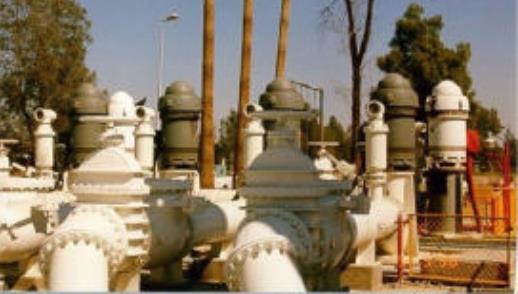
Mexicali I Projects
Repairs to South Sewage Collector: The Mexicali I projects totaled $51.5 million and focused on providing sewage collection services for neighborhoods on septic systems. These projects were completed in late 2003/early 2004, and included the following key infrastructure:
- Installation of sewage collection systems in 52 colonies located in the western part of Mexicali.
- Reposition of 36 kilometers of sewage collectors
- Construction of 7.650 km of new sewage collectors
- Installation of telemetry equipment for the municipal collection and pumping systems
- Rehabilitation of Pump Stations No. 1, 2, 3, and the Gonzales Ortega lift station
- Construction of the Orizaba, Orizaba II, Pump Station 8, and the Santorales Pump Station.
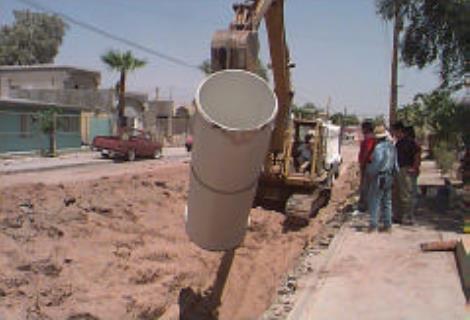
Mexicali II Projects
Repairs to South Sewage Collector: The Mexicali I projects totaled $51.5 million and focused on providing sewage collection services for neighborhoods on septic systems. These projects were completed in late 2003/early 2004, and included the following key infrastructure:
- Installation of sewage collection systems in 52 colonies located in the western part of Mexicali.
- Reposition of 36 kilometers of sewage collectors
- Construction of 7.650 km of new sewage collectors
- Installation of telemetry equipment for the municipal collection and pumping systems
- Rehabilitation of Pump Stations No. 1, 2, 3, and the Gonzales Ortega lift station
- Construction of the Orizaba, Orizaba II, Pump Station 8, and the Santorales Pump Station.
Las Arenitas WWTF: The Mexicali II WWTF is outside the Salton Sea Transboundary Watershed. Effluent from Las Arenitas is now discharged to a tributary of the Rio Hardy in Mexico. The WWTF is fully functional. The cost for this project was approximately $26 Million. Las Arenitas WWTF was designed to prevent any remaining untreated municipal sewage in Mexicali from being discharged into the New River. As a result of Las Arenitas, 15-20 million gallons per day of raw sewage that were routinely present in the New River at the Border have been eliminated. Further, Mexico disinfects the treated wastewater from the Las Arenitas lagoons, and it also built some wetlands adjacent to the WWTF to further polish the treated wastewater.
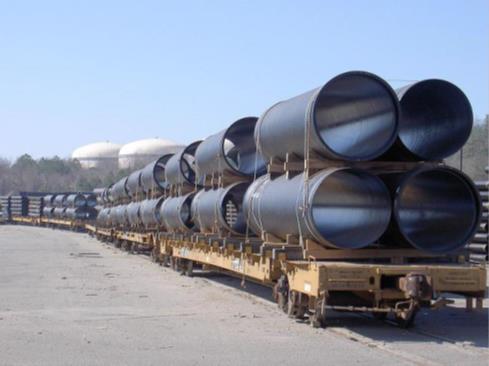
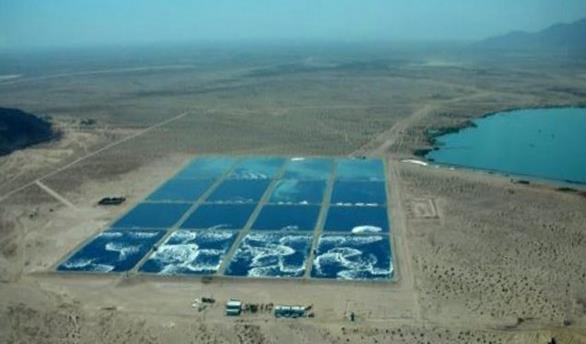
Mexico's Regulatory Efforts
2011, 2013: Besides sanitation projects, another BTC priority has been to follow up on the untreated and partially treated discharges of wastes from industrial point sources. In this regard, Mexico’s Comision Nacional del Agua (CONAGUA) has led the efforts to ensure industries that discharge wastes to waters tributary to the New River in Mexicali comply with Mexico’s water quality standards. All of the industrial discharges that significantly contributed to the impairment of the Tula West Drain, a tributary to the New River in Mexicali, were eliminated in the mid 2000’s. More recently, regulatory efforts have focused on the four main slaughterhouses in Mexicali (Su Karne, Don Fileto, Bachoco, and the Mexicali’s TIF). Thanks to CONAGUA’s regulatory efforts, the discharges from Su Karne and Don Fileto to surface waters tributary to the New River have been eliminated. CONAGUA has also filed litigation and enforcement against Bachoco and TIF to ensure they comply with Mexico’s standards. In 2006, Mexico finished encasing the New River as it courses the metropolitan area. This has helped somewhat in reducing the amount of trash that is dumped in the New River.
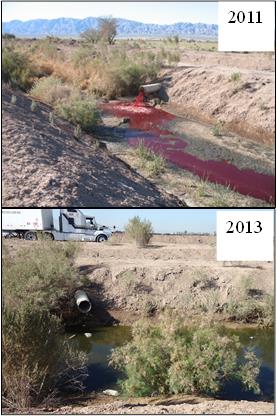
ON-GOING SANITATION PROJECTS
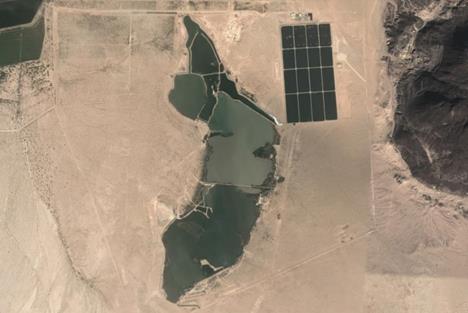 Las Arenitas WWTF and Constructed Wetlands: Nowadays, Mexicali is divided into the Mexicali I, Mexicali II, Mexicali III, and Mexicali IV areas for planning purposes. Municipal wastewater generated by the Mexicali I and III areas is treated by the Zaragoza Lagoons (a.k.a. “Mexicali I WWTF) and then discharged into a drain that discharges into the International Drain, which in turn discharges into the New River right at the Border. Wastewater from the Mexicali II area is treated by the Las Arenitas WWTF and discharged into a drain tributary to the Rio Hardy. Mexico built wetlands adjacent to Las Arenitas WWTF to further polish the wastewater discharged to the drain and create wildlife habitat. Further, Mexico is expanding the treatment capacity of Las Arenitas WWTF from 20 to 40 mgd to treat the projected wastewater flows from the Mexicali IV area. The expansion is expected to be completed by 2016. Key components for this major sewage infrastructure include:
Las Arenitas WWTF and Constructed Wetlands: Nowadays, Mexicali is divided into the Mexicali I, Mexicali II, Mexicali III, and Mexicali IV areas for planning purposes. Municipal wastewater generated by the Mexicali I and III areas is treated by the Zaragoza Lagoons (a.k.a. “Mexicali I WWTF) and then discharged into a drain that discharges into the International Drain, which in turn discharges into the New River right at the Border. Wastewater from the Mexicali II area is treated by the Las Arenitas WWTF and discharged into a drain tributary to the Rio Hardy. Mexico built wetlands adjacent to Las Arenitas WWTF to further polish the wastewater discharged to the drain and create wildlife habitat. Further, Mexico is expanding the treatment capacity of Las Arenitas WWTF from 20 to 40 mgd to treat the projected wastewater flows from the Mexicali IV area. The expansion is expected to be completed by 2016. Key components for this major sewage infrastructure include:
- The Abasolo collector, sub-collector, force main, and lift station
- Ladrilleros collector
- Islas Agrarias collector, lift station, and force main
- Collector M4
- Pumping Plant No. 10
- Force Main 10 to Las Arenitas
WATER QUALITY IMPROVEMENTS
The Quick Fixes and Mexicali I and II binational projects eliminated the 10 to 20 mgd of raw sewage that were historically present in the New River at the Border. Mexico’s regulatory efforts have also eliminated untreated and partially treated industrial discharges of wastes into the New River in Mexico. All of these have resulted in significant, measurable improvements in water quality of the New River at the Border, particularly as it relates to pathogens, nutrients, bacteria, and dissolved oxygen. The USIBWC continue to monitor bacteria in the New River every month. The available Regional Water Board data for the New River at the Border show that New River bacteria were significantly reduced by about 10-fold, and that volatile organic compounds were reduced to below detection limits as a result of Las Arenitas. The dissolved oxygen in the River at Border has also improved dramatically and significantly to a point that it eliminated the stench that used to characterize the River at the Border. Further, the improvements and new WWTF have reduced the nutrient loading into the Salton Sea by about 20%. Table 1, below, shows a comparison of New River water quality at the Border before and after completion of the binational projects, including Las Arenitas going on line:
| ISSUE | PRE BINATIONAL PROJECTS | POST BINATIONAL PROJECTS |
|---|---|---|
| Fecal, E. Coli | > 1,000,000 | ~ 100 - 60,000 |
| Dissolved Oxygen | < 1.0 mg/L | ~ 5.0 mg/L |
| Nutrients (PO4) | 40% of Load to Salton Sea | 20% of Load to Salton Sea |
| VOCs | Some detected | Non-detect |
| Trash | > 150 cu yds/year | > 150 cu yds/year |
| Pesticides | Detected | Still a problem |
OUTLOOK & ON-GOING WATER QUALITY THREATS
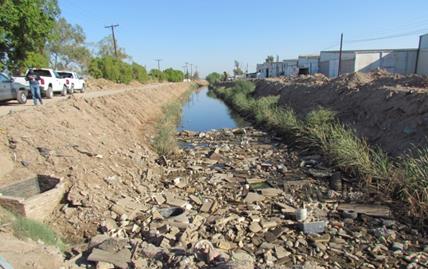 Trash in Tula West Drain: In spite of the relatively recent significant water quality improvements achieved through the binational projects and Mexican regulatory efforts, there are still New River water quality impairments at the Border caused by dumping of trash, point and non-point sources of pollution: pesticides from agricultural runoff; nutrients, and pathogens from confined animal feeding operations as well as from slaughterhouses in Mexicali.
Trash in Tula West Drain: In spite of the relatively recent significant water quality improvements achieved through the binational projects and Mexican regulatory efforts, there are still New River water quality impairments at the Border caused by dumping of trash, point and non-point sources of pollution: pesticides from agricultural runoff; nutrients, and pathogens from confined animal feeding operations as well as from slaughterhouses in Mexicali.
Additional measures must be taken to address the indiscriminate dumping of trash into the New River and its tributaries, the nutrients and pathogens from Mexicali's Zaragoza wastewater treatment lagoons, the untreated and partially treated discharges of industrial wastes from Mexican-owned facilities, agricultural runoff (and the pesticides associated with it) from the Mexicali Valley, and urban and storm runoff from the municipality. Further, the Regional Board recently learned from Mexico that key sewage infrastructure in the Mexicali I and II areas very near, at, and past its service life expectancy and, consequently, in immediate need of repair and/or replacement. This includes sewage collectors, lift stations, pumping plants and sewage vacuum trucks used to clean the sewage collectors. The BTC has made addressing this problem its top priority. It is estimated that addressing this problem is approximately $35 Million.
Failure to address this problem now would undoubtedly again result in discharges of raw sewage into the New River, which would wipe out the recent improvements in water quality. Besides the concern with the above-mentioned infrastructure, Figure 1, below, delineates areas that continue to be of concern and the focus of the Binational Technical Committee. In recognition to the ongoing water quality problems and ongoing water quality threats from discharges of wastes into the New River and its tributaries in Mexicali and the city’s sewage infrastructure, in 2009, AB1079 was signed into law. The law directs the California-Mexico Border Relations Council (CMBRC) to prepare a strategic plan. In May 2012, and as Chair of the CMBRC, Cal/EPA released its New River Improvement Project Strategic Plan (Strategic Plan). A copy of the Strategic Plan can be found at: https://calepa.ca.gov/wp-content/uploads/sites/6/2016/10/Border-CMBRC-2011yr-StrategicPlan.pdf.
The Strategic Plan includes, in relevant part, a series of recommendations to address New
River pollution in Mexico:
- Municipal wastewater treatment
- Consideration of converting open agricultural drains into vegetated drains to uptake nutrients and other pollutants
- Cover urban open storm drains to minimize and eliminate trash dumping
- Development and implementation of a Watershed Management approach to comprehensively address pollution
As discussed in a previous paragraph, the Regional Water Board is a member of the Binational Technical Committee (BTC) for the New River/Mexicali Sanitation Program. 1 The charge of the BTC is to identify pollution problems, oversee development and implementation of the binational sanitation projects agreed upon by Mexico and the US and make project and policy recommendations to address overall New River pollution from Mexico. The BTC now meets and conducts the Observation Tour of the New River every three months, in Mexicali. The Regional Water Board uses its BTC membership to advocate that Mexico implements the Strategic Plan’s recommendations.

Figure 1: Problematic Areas: (1) industrial discharges; (2) trash in open drain; (3) trash in open drain; (4) treated but undisinfected municipal wastewater; (5) trash in open drains; (6) industrial discharges and trash in open drains; and (7) industrial discharges.
1 The State Water Resources Control Board is also a BTC member, but to maximize our limited resources and minimize cost associated with this Border activity, only Region 7 attends the BTC meeting and tours in Mexicali.


